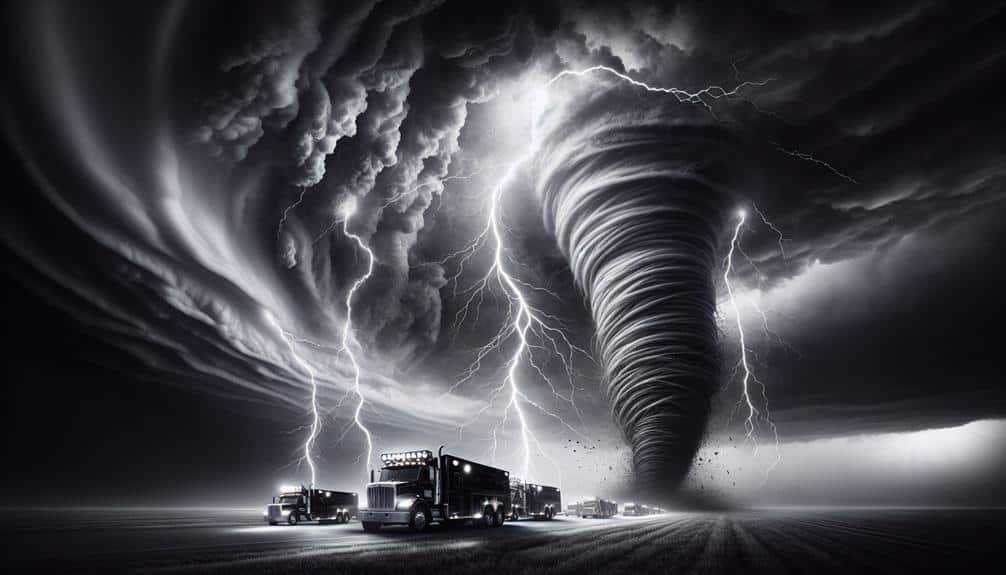We employ advanced techniques for storm chaser cell monitoring, integrating Doppler radar systems to measure wind speed and precipitation intensity. Mobile weather stations, equipped with high-precision sensors, capture crucial meteorological data in real-time. Satellite data integration allows us to track atmospheric conditions, enhancing predictive accuracy. Doppler radar analysis aids in identifying tornado formation, while communication tools like satellite phones guarantee real-time data sharing. GPS tracking systems guide our teams safely, and data logging techniques assure accurate data collection. For those seeking detailed insights, our strategies unveil significant advancements in storm monitoring technology.
Key Points
- Integrate real-time satellite data with radar systems for precise storm tracking and monitoring.
- Deploy mobile weather stations with high-precision sensors to capture critical meteorological data.
- Utilize GPS tracking systems to ensure accurate positioning and safety of storm chaser cells.
- Leverage Doppler radar technology to measure wind velocity and detect storm patterns.
Utilizing Weather Radar
How can we leverage advanced weather radar technology to enhance our storm chaser cell monitoring capabilities?
By harnessing state-of-the-art radar interpretation, we can improve our storm tracking techniques to a large extent. Advanced Doppler radar systems allow us to measure wind velocity and precipitation intensity within storm cells. These data points enable us to predict storm behavior with greater accuracy, giving us the freedom to make more informed decisions in real-time.
Radar interpretation is essential for identifying rotation within supercells, which can indicate the formation of tornadoes. By analyzing velocity data, we can detect mesocyclones and issue timely warnings. High-resolution radar also aids in determining the exact location and potential path of severe weather events. This precision is invaluable for deploying resources strategically and ensuring the safety of storm chasers in the field.
Moreover, dual-polarization radar provides additional data on precipitation types, from rain and hail to snow and sleet. This information is crucial for tailoring our storm tracking techniques to different weather scenarios.
Leveraging these advanced radar capabilities allows us to enhance our situational awareness, optimize our monitoring strategies, and ultimately achieve greater flexibility in our storm chasing endeavors.
Mobile Weather Stations
Leveraging advanced radar technology to augment our storm tracking, we must now integrate mobile weather stations to gather real-time, ground-level data on atmospheric conditions directly within the storm environment. These mobile weather stations, equipped with high-precision sensors, enable us to capture critical data such as temperature, humidity, wind speed, and barometric pressure.
By deploying these stations strategically within the storm's path, we enhance our ability to perform precise remote monitoring of rapidly changing meteorological variables.
Field deployment of mobile weather stations is pivotal for capturing localized phenomena that static stations and radar might miss. This real-time data collection allows for immediate analysis, enabling us to make quick, informed decisions.
For example, detecting sudden drops in atmospheric pressure can signal the formation of a tornado, providing invaluable lead time for issuing warnings.
Remote monitoring capabilities mean we don't have to be physically present to gather data, offering us the freedom to cover a larger area and reducing the risk to personnel.
Satellite Data Integration
By integrating satellite data, we gain real-time access to atmospheric conditions, which greatly enhances our predictive accuracy.
These high-resolution datasets allow us to create more detailed and reliable storm maps.
Consequently, our ability to track and forecast severe weather events improves, leading to better-informed decision-making.
Real-Time Data Access
Integrating real-time satellite data into our storm chaser cell monitoring systems enables us to analyze weather patterns instantaneously and make data-driven decisions. Real-time data access revolutionizes our ability to perform remote monitoring, allowing us to stay updated with the latest meteorological developments. With satellite data integration, we can visualize atmospheric conditions in high resolution, providing an unparalleled perspective on storm dynamics.
Data visualization tools play an important role in transforming raw satellite data into actionable insights. By leveraging these tools, we can create detailed maps and models that highlight key weather parameters such as wind speed, precipitation rates, and temperature variations. This enables us to identify the formation and progression of storm cells with remarkable accuracy.
Moreover, the real-time nature of this data guarantees that we can adapt our strategies on the fly. By continuously monitoring the evolving weather patterns, we can make quick decisions to optimize our storm-chasing routes, enhancing both safety and efficiency. This integration empowers us to achieve a higher level of situational awareness, providing the freedom to chase storms with confidence and precision.
As we move forward, this real-time access will remain vital to our storm-chasing endeavors.
Improved Accuracy Predictions
Satellite data integration greatly enhances our ability to predict storm behavior with enhanced precision, offering a more detailed understanding of meteorological phenomena. By leveraging high-resolution satellite imagery and advanced algorithms, we can significantly enhance storm tracking, thereby improving our forecast accuracy. This integration allows us to analyze atmospheric patterns, temperature variations, and moisture content in real-time, providing a thorough dataset for predictive modeling.
We employ geostationary satellites for continuous monitoring, ensuring that we capture every crucial moment of storm evolution. These satellites offer data with temporal resolution, facilitating the timely identification of storm cells and their trajectories. By combining this satellite data with ground-based radar and weather stations, we create a multi-faceted approach that enhances our predictive capabilities.
Moreover, the assimilation of satellite data into numerical weather prediction models enables us to reduce uncertainties in storm forecasts. This leads to more dependable predictions that empower storm chasers and meteorologists to make informed decisions.
The ability to foresee changes in storm intensity and direction is vital for timely warnings and effective disaster preparedness. By integrating satellite data, we achieve a higher level of forecast accuracy, ultimately granting us greater flexibility to protect lives and property.
Enhanced Mapping Capabilities
Leveraging high-resolution satellite data, we can create detailed and accurate storm maps that provide real-time insights into storm cell developments and movements. This integration transforms our ability to track and visualize storms, enhancing our decision-making process and situational awareness.
By incorporating satellite data, we achieve:
- Advanced Storm Tracking: High-resolution imagery allows us to pinpoint storm cells with unprecedented location accuracy, enabling precise monitoring and timely response.
- Enhanced Storm Visualization: Detailed satellite images facilitate better mapping integration, giving us a clearer and more thorough view of storm structures and dynamics.
- Real-Time Updates: Continuous satellite feeds supply ongoing data, ensuring we stay updated with the latest developments and can adjust our strategies in real-time.
- Data-Driven Insights: By analyzing satellite data, we can derive critical insights about storm behavior, intensity, and trajectory, empowering us with actionable information.
These advanced storm tracking capabilities, coupled with enhanced storm visualization, make our storm chasing efforts more effective and efficient.
We no longer rely solely on ground-based observations; instead, we harness the full potential of satellite technology. This approach not only improves our location accuracy but also allows us to make more informed decisions, ultimately granting us the freedom to navigate and respond to storms with greater confidence and precision.
Doppler Radar Analysis
Doppler radar analysis provides us with detailed real-time data on storm cell velocity and structure, vital for accurate storm tracking. By analyzing the Doppler radar's velocity signatures, we can identify rotation within storm cells, aiding in the prediction of severe weather events such as tornadoes. The radar's ability to detect and measure the motion of precipitation particles allows us to determine storm patterns and intensities with remarkable precision.
Through the use of Doppler radar, we can monitor the movement of storm cells, thereby anticipating changes in direction and speed. This data is essential for issuing timely warnings and ensuring safety. By examining the reflectivity and velocity data, we can distinguish between different types of precipitation, such as rain, hail, or snow, further enhancing our ability to forecast storm impacts.
Additionally, Doppler radar enables us to detect wind shear and turbulence within storm environments, vital parameters for understanding storm dynamics. With these capabilities, we can enhance our situational awareness and improve our decision-making processes.
As storm chasers, leveraging Doppler radar technology allows us to pursue our passion while prioritizing safety and gaining a deeper understanding of severe weather phenomena.
Communication Tools

As we interpret Doppler radar data to track storm cells, effective communication tools are crucial for coordinating real-time information and facilitating swift response among storm chasers. The reliability of our data exchange relies on signal strength and network coverage, which directly impact the efficiency of our operations.
We rely on a range of communication tools to maintain uninterrupted data flow and situational awareness. Here are the primary tools we utilize:
- Cellular Networks: These provide wide network coverage, essential for real-time data sharing. We assess signal strength constantly to ensure our devices maintain peak connectivity.
- Satellite Phones: In areas where cellular networks falter, satellite phones offer a robust alternative. Their ability to operate independently of terrestrial networks ensures continuity in our communications.
- Radio Communication: High-frequency radios serve as a dependable backup, especially in remote areas. They're less susceptible to network coverage issues and provide direct, clear channels for urgent coordination.
- Internet-Based Platforms: Using services like Slack or Discord allows us to share detailed data and multimedia, facilitating thorough situational assessments and strategic planning.
GPS Tracking Systems
In our storm chaser cell monitoring, we utilize GPS tracking systems to provide real-time location updates.
This technology guarantees data accuracy enhancement, allowing us to make informed decisions quickly.
Real-time Location Updates
Utilizing GPS tracking systems, we can obtain real-time location updates essential for accurately monitoring storm chaser cells. This capability is vital for effective weather tracking and storm interception strategies. High-precision GPS provides us with the necessary location accuracy to predict storm paths and make timely decisions.
Real-time location updates enable the following:
- Enhanced Safety: Knowing the exact position of storm chasers allows us to guarantee their safety by guiding them away from dangerous conditions.
- Improved Data Collection: By tracking storm cells with precision, we can collect more accurate meteorological data, essential for thorough storm prediction models.
- Efficient Resource Allocation: Real-time updates help us allocate resources more effectively, ensuring that storm chasers are deployed where they're needed most.
- Quick Response: Immediate location data allows for rapid response to changing weather conditions, enhancing our ability to intercept storms at best moments.
Our GPS tracking systems provide the backbone for these operations, offering unparalleled accuracy and reliability.
Data Accuracy Enhancement
With the integration of advanced GPS tracking systems, we greatly enhance data accuracy, securing precise storm cell monitoring and more reliable storm prediction models. These systems allow us to implement robust data verification techniques, reducing errors in our measurements to a great extent.
By cross-referencing multiple GPS data points, we can identify inconsistencies and apply error detection methods to correct them. This assures the data we collect is both precise and reliable.
Moreover, our attention to signal strength analysis and network coverage assessment plays an essential role in maintaining data integrity. By continuously monitoring signal strength, we identify weak spots and optimize our equipment placement to maximize coverage. This proactive approach minimizes data loss and ensures consistent tracking even in challenging weather conditions.
Additionally, we leverage network coverage assessment to determine the best possible routes and positioning for our storm chasers. This strategic planning, supported by real-time data, offers us the flexibility to adapt quickly to changing storm dynamics while maintaining high data accuracy.
Through these detailed techniques, we enhance our storm cell monitoring capabilities, providing more precise and timely information for forecasting and public safety.
Data Logging Techniques

Accurate data recording techniques are necessary for capturing the dynamic and often unpredictable behavior of storm systems. As storm chasers, we need robust data tracking and monitoring techniques to make sure that every piece of data we collect is both precise and actionable.
Let's explore the key components that make our data recording process effective:
- Real-time Data Synchronization: By leveraging cloud-based platforms, we can guarantee that data from various sensors and devices is synced in real-time. This minimizes data loss and provides immediate access to the latest information.
- Automated Data Recording: Utilizing automated systems reduces human error and increases the efficiency of data collection. Devices such as automated weather stations can continuously record parameters like temperature, humidity, and wind speed.
- Redundant Systems: Implementing backup systems ensures that if one recording device fails, another can seamlessly take over. This redundancy is important for maintaining data integrity during severe weather events.
- High-Frequency Sampling: High-frequency sampling allows for more detailed data capture. This technique is particularly useful for analyzing rapid changes in storm behavior, providing a more detailed dataset for subsequent analysis.
Frequently Asked Questions
How Can Storm Chasers Prepare for Unexpected Severe Weather Conditions?
To prepare for unexpected severe weather conditions, we should identify emergency shelters, establish robust communication strategies, and use real-time data. This analytical approach guarantees our safety while maintaining the freedom to chase storms effectively.
What Safety Protocols Should Storm Chasers Follow While in the Field?
Some may think it's vital, but following safety protocols is essential. We should identify emergency shelters, plan evacuation routes, establish reliable communication plans, and keep emergency contacts on hand to make sure our safety and freedom.
How Do Storm Chasers Verify the Accuracy of Their Collected Data?
To validate the accuracy of our collected data, we perform rigorous data verification and guarantee our equipment calibration is precise. We cross-check findings with multiple sources and regularly update our tools to maintain high standards.
What Essential Gear Should Storm Chasers Always Carry With Them?
When it comes to storm chasing, we can't afford to be caught off guard. Essential gear includes robust communication devices and thorough emergency supplies. Data-driven decisions enhance safety and guarantee we maintain our freedom to explore.
How Can Storm Chasers Collaborate Effectively With Local Emergency Services?
We can collaborate effectively with local emergency services by establishing clear communication protocols and emergency response plans. Data sharing and fostering community partnerships guarantee accurate information flow, enhancing public safety while respecting our freedom to chase storms.
